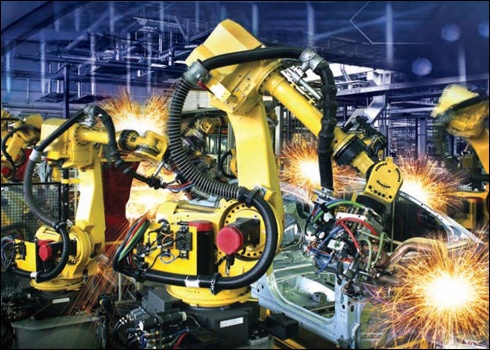600V Industrial Ethernet Cable: Safety & NEC Considerations
Installing Ethernet on the factory floor is not new. What is changing is its adoption for controlling communications to power-hungry machines, often in areas regulated by the National Electrical Code (NEC)*.
High-powered machinery in code-regulated environments requires higher voltage cable, making the use of 600V Ethernet cables more common. When Ethernet cable is used in such a 600-volt environment, electrical safety becomes a design consideration.

The challenge is that Ethernet products have not traditionally been offered in a form that easily integrates with industrial machinery AND conforms to safety regulations. If you suspect that your 600V Ethernet application needs to conform to the NEC regulations, or if you simply want to understand 600V cable safety considerations, read on.
The image to the left demonstrates an example of some power-hungry machines using 600 volts often require Ethernet and adjacent cables that meet the safety standards of regulatory bodies.
Two Types of Regulatory Environments
- NFPA 70
- NFPA 79
The main objective in insuring overall communications cable safety has less to do with electrical safety and more to do with fire and burn performance. However, once 600V of potential energy is involved, electrical safety becomes a design consideration.
The first step in selecting the right 600V Ethernet cable is to determine the applicable regulatory environment. There are two types of regulations to consider, as listed above, and they apply to different situations.
| NFPA 70 | NFPA 79 | ||
|---|---|---|---|
|
Regulation Name |
National Electrical Code (NEC) |
Electrical Standard for Industrial Machinery |
|
|
Where Applicable |
All field wiring installed and terminated at the manufacturing site |
Manufacturer supplied electrical and electronic equipment where:
|
|
If the application is one that falls under NFPA 79**, then the cable requirements are less rigorous. This is because the inherent mechanical protection of the machine itself is considered part of its safety attributes. This wiring is typically well protected and not accessible to untrained workers.
If the wiring is field wiring, however, then NEC regulations likely apply. These regulations specify that:
- AWM (Appliance Wiring Material) cables are not recognized by the NEC and cannot be used unless the cable carries another approval suitable for the environment, such as Type TC.
- All cables in a 600V cable tray environment (zone) must be a 600V listed type approved for use under NEC, for example, Type TC.
- Many types of cable are not permitted in a 600 volt environment such as Types PLTC, CM, CMG, CMP or AWM.
For example, 300V PLTC Cable with 600V AWM rating would NOT be permitted in a 600V NEC wiring environment.
Importance of Crush Resistant Data Cable
For field wiring using cable trays, mechanical safety, crush resistance and fire resistance are all important. For example, under the NEC, the smallest conductor allowed in a 600V cable tray is 18AWG, with significant insulation thickness and abrasion resistance. 600V AWM wiring does not meet the mechanical requirements of the NEC for cable tray or power-limited cable tray applications.
In fact, crush resistance is not only important to safety, but in the case of data cables, crush resistance can be a significant factor in network performance.
In data cables, the cable designs include important aspects not typically found in other electrical conductors. Signal transmission performance is enhanced if the conductors in each pair are uniform and carefully spaced with respect to each other. If data cables are crushed by heavy power cables, there will likely be signal loss and degraded performance.
To maintain performance, 600V tray-rated cables need to resist the bending, crushing, heating and abrasion loads associated with a power cable environment.
600V TC-rated Cat 5e Cable:
- Lower-Cost Deployment
- Safety Assurance
- Good Reliability
A 600V tray-rated Ethernet cable is the only solution that meets the requirements of the NEC if the cable must run in a 600V environment. An example of a system that might benefit from the use of TC Ethernet is a connection to a remote drive. It may be convenient and economical to run the control signals in the same cable tray that feeds the drive, rather than install separate communications infrastructure.
The same would be true for any remote system component that has both a power feed and a network communications requirement.
600V TC-rated Ethernet cables provide cost savings by averting the need for separate communications infrastructure. They also provide code-compliant safety assurance as set by the NEC and contribute to good network performance.
Further details on selecting 600V Ethernet cable to meet regulatory requirements are provided in the white paper available below.
*The National Electric code is also known as NFPA 70. “NFPA” stands for National Fire Protection Association. It is an international non-profit organization that develops and publishes codes and standards for minimizing fire hazards.
**NFPA 79 is the Electrical Standard for Industrial Machinery.
